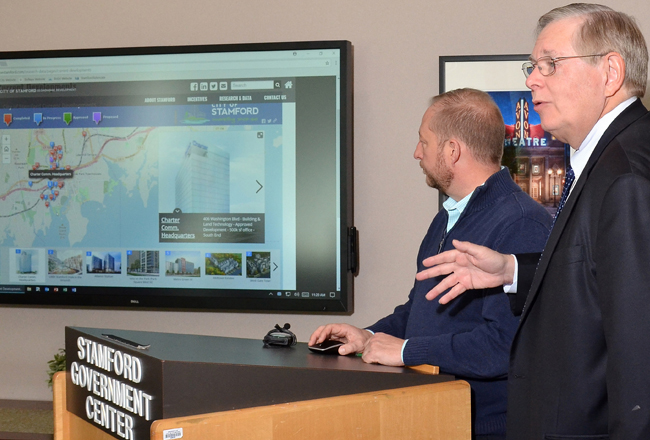Stamford Mayor David Martin: Improving quality of life a top priority

Even after a decisive re-election victory in November, Stamford Mayor David Martin gives the impression that some of the charges flung his way during the campaign still smart.
“There was, and still is, a lot of talk about Stamford being ”˜overdeveloped”™,” he said in his Stamford Government Center office on Washington Boulevard. Anyone taking such a stance is either “extremely naïve,” trying to score political points “or is just plain wrong,” he said.
Indeed, development was one of the key issues raised by Martin”™s Republican opponent Barry Michelson, who during the campaign repeatedly alleged that the administration was bending over backwards to allow developers to run riot over zoning laws, resulting in increased traffic congestion and overcrowded streets.
Although Martin won by nearly 24 percentage points, such talk has continued, to the mayor”™s annoyance.
“Look, we”™ve had explosive (population) growth here and companies want to come here,” Martin said. “It”™s all about quality of life. And I”™d rather have companies and people wanting to move to Stamford than turn back the clock to where it was 20 or 25 years ago.”
Back then, the mayor said, downtown was in effect a ghost town. This December, however, “We had huge crowds of families come into downtown for the Christmas tree lighting with Santa Claus. Fifteen years ago, that was all brownfields and nobody would have been caught going there.”
The city is growing faster than the rest of the state, according to a January 2017 study by The Yankee Institute, which reported that Stamford”™s population has grown 5.1 percent over the past year ”“ the nation”™s population grew by just 0.7 percent over the same period ”“ “which has spurred more housing investment, which has led to more employment and property tax revenue.”
The study also found that Stamford”™s list of taxable properties has increased 2.5 percent since 2015, accounting for 73 percent of the city”™s revenue. Its 4.1 percent unemployment rate compared favorably with the statewide rate of 5.1 percent. The city”™s median income was $79,359, nearly 13 percent higher than the state median income of $70,331.
But Stamford”™s cost of living is also 60 percent higher than that in the rest of the U.S., according to municipal statistics database Sperling”™s Best Places.
Martin is unapologetic about that last fact. “Everyone who moves here can”™t afford a place in Harbor Point,” he said, referring to Building and Land Technology”™s transit-oriented, mixed-use development the Long Island Sound, where demand is so high that BLT expects to ultimately construct more than 4,000 apartment units. “But we”™re also trying to pay attention to the needs of lower-income people.”
As evidence, he pointed to such recent developments as Metro Green ”” consisting of three mixed-income apartment buildings on Atlantic Street ”” and a 47,000-square-foot affordable housing building under construction at 72 Franklin St. Another point of pride is Stamford Urby, a $200 million residential development that broke ground in October at the site of Stamford”™s long-derided “hole in the ground” on the corner of Greyrock Place and Tresser Boulevard.
Not that everything”™s coming up roses for the city. One Elmcroft Road, once home to Pitney Bowes, has some 500,000 square feet available following that company”™s move to 3001 Summer St. in 2014, while 712,000 square feet of office space sits empty at UBS former headquarters at 677 Washington Blvd. Royal Bank of Scotland has cut approximately 630 jobs over the past two years at its 400,000-square-foot North American headquarters at 600 Washington Blvd., although RBS has repeatedly promised that it will stay in Stamford.
“Stamford is so much more than UBS and RBS,” said city Director of Economic Development Thomas Madden. “We”™re home to 90 major companies, 60 of which have $100 million in annual revenue or more.”
Among those companies, Henkel over the summer relocated its North American headquarters to Stamford from Scottsdale, Arizona, and Charter Communications in October announced plans to build a 500,000-square-foot, 15-story headquarters at 406 Washington Blvd.
The mayor touted the efforts of the Fairfield County Five, an economic development group composed of Stamford, Greenwich, Norwalk, Westport and Fairfield. It promotes the five municipalities as a bloc instead of the “balkanized” approach that pits Gold Coast communities against each other. The group made a pitch to New York City business leaders on Nov. 2 in Manhattan and plans a return visit to Gotham in April or May.
Madden said the city”™s new website, Choose Stamford, provides current and potential businesses and residents with a detailed snapshot of what the city offers and has in the works.
With quality of life in mind, Stamford officials plan to make “dark fiber” ”” unused optical fiber for fiber-optic communication ”” available at all of Stamford”™s intersections, thus allowing for cheap, more efficient internet access. The street-corner service will be especially appealing to college students and recent graduates who have grown used to having that kind of service at school, Madden said.
As for the city”™s congested streets, Martin said efforts continue to synchronize all of Stamford”™s 209 traffic signals and upgrade its traffic cameras to improve the flow. Even so, he said, “Forty percent of the residents in downtown and the South End don”™t even own cars.”
Martin said he”™s aware of Stamford”™s growing pains and is doing what he can to address them. “Things are getting better, and they”™re going to continue to get better,” he said. “But a lot of these problems we face today have been problems for years.”
“My magic wand only has so much magic in it, and I can”™t fix everything in two seconds.”